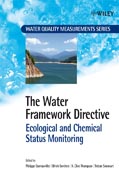
The water framework directive: ecological and chemical status monitoring
Quevauviller, Philippe
The Water Framework Directive imposes wide scale monitoring programs for all waters to achieve "good status" objectives by 2015. Reflecting this recently introduced legislation, this volume is edited by EC representatives who were involved in establishing the legislation, along with colleagues in various waterinstitutions who are implementing the legislation. The Water Framework Directive provides a comprehensive approach and guidance to researchers, scientists,and groundwater scientists in the environment and related industries on the theoretical and practical aspects for implementing the directive. INDICE: Series Preface. Preface. List of Contributors. SECTION 1 GENERAL WFD MONITORING FEATURES. 1.1 Water Status Monitoring under the WFD (Philippe Quevauviller). 1.2 Chemical Monitoring of Surface Waters (Peter Lepom and Georg Hanke). 1.3 The Monitoring of Ecological Status of European Freshwaters (Angelo Solimini, Ana Cristina Cardoso, Jacob Carstensen, Gary Free, Anna-Stiina Heiskanen, Niels Jepsen, Peeter Noges, Sandra Poikane and Wouter van de Bund). Section 2:CASE STUDIES ON MONITORING DIFFERENT AQUATIC ENVIRONMENTS UNDER THE WFD. 2.1 Lake monitoring in Sweden (Hkan Marklund). 2.2 River monitoring (Elena Perez Gallego). 2.3 Groundwater monitoring: Implementation in two Member States (Rob Ward, Johannes Grath and Andreas Scheidleder). 2.4 Coastal and marine monitoring (Patrick Roose). SECTION 3: ANALYTICAL TOOLS IN SUPPORT OF WFD MONITORING. 3.1 Emerging methods for water monitoring in the context of the WFD (Richard Greenwood, Graham A. Mills and Ian J. Allan). 3.2 Diagnostic water quality instruments for use in European Water Framework Directive (J.L. Maas, C.A. Schipper, R.A.E. Knoben, M.J. van den Heuvel-Grever, P.J. den Besten and G-J.de Maagd). SECTION 4: MODELLING TOOLS IN SUPPORT OF WFD MONITORING. 4.1 Joint modelling and monitoring of aquatic ecosystems (Jens Christian Refsgaard, Lisbeth Flindt Jørgensen, Anker Lajer Højberg, C. Demetriou, G. Onorati and Gyrite Brandt). 4.2 Harmonised modelling tools and decision-making process (Zbyszek W. Kundzerwicz and Fred F. Hatterman). SECTION 5: HYDROGEOLOGICAL COMPONENTS AND GROUNDWATER STATUS. 5.1 Scientifically-based monitoring - Overriding influence of hydrogeological typology (Didier Pennequin and Stephen Forster). 5.2 Contribution of hydrogeological mapping to water monitoring programmes (Wilhem F.Struckmeier). 5.3 Establishing environmental groundwater quality objectives (Dietmar Müller). SECTION 6: SEDIMENT MONITORING. 6.1 Sediment dynamics and influence on the design of monitoring programmes (Sue White). 6.2 Monitoring sediment quality using toxicity tests as primary tool for any risk assessment (Wolfgang Ahlf, Susanne Heise, Peter Heininger and Ute Feiler). SECTION 7: RISK ASSESSMENT LINKED TO MONITORING. 7.1 Risk Assessment linked to Monitoring and Management (Jos Brils, Damia Barceló, Winfried E.H. Blum, Werner Brack, Bob Harris, Dietmar Mller, Philippe Ngrel, Vala Ragnarsdottir, Wim Salomons, Thomas Track and Joop Vegter). 7.2 Emerging contaminants at water-sediment system: Casestudy of pharmaceuticals and brominated flame retardants in the Ebro river basin (Mira Petrovic, Ethel Eljarrat, Meritxell Gros, Agustina de la Cal and Damia Barceló) 7.3 Assessment of metal bioavailability and natural background levels - WFD monitoring from the perspective of metals industry (Patrick Van Sprang, Katrien Delbeke, Lidia Regoli, Hugo Waeterschoot, Frank Van Assche, William Adams, Delpine Haesaerts, Claire Mattelet, Andy Bush, Lynette Chung and Violaine Verougstraete). 7.4 Freshwater ecosystem responses to climate change: theEuro-limpacs project (Rick Battarbee, Martin Kernan, David M. Livingstone, Uli Nickus, Piet Verdonschot, Daniel Hering, Brian Moss, Dick Wright, Chris Evans, Joan Grimalt, Richard Johnson, Ed Maltby, Conor Linstead and Richard Skeffington). SECTION 8: ENSURING DATA QUALITY. 8.1 NORMAN - Network of Reference Laboratories for Monitoring of Emerging Substances (Jaroslav Slobodnik and Valeria Dulio). 8.2 Data quality assurance of sediment monitoring (Ulrich Förstner,Susanne Heise, Wolfgang Ahlf and Bernard Westrich). SECTION 9: REPORTING REQUIREMENTS. 9. Reporting requirements for priority substances (Valeria Dulio andAnne Morin). Section 10: CONCLUSIONS. 10.1 Needs for an operational science-policy mechanism in support of WFD monitoring ? National and regional examples (Philippe Quevauviller, Bob Harris and Philippe Vervier). 10.2 Support to WFD research needs: Current activities and future perspectives in the context of RTD Framework Programmes (Andrea Tilche). Index.
- ISBN: 978-0-470-51836-6
- Editorial: John Wiley & Sons
- Encuadernacion: Cartoné
- Páginas: 496
- Fecha Publicación: 24/10/2008
- Nº Volúmenes: 1
- Idioma: Inglés
